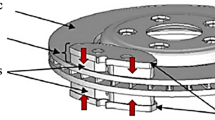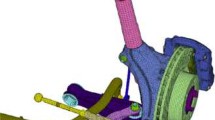Abstract
Friction-induced vibration is a common phenomenon in nature and thus has attracted many researchers’ attention. Many of the mathematical models that have been proposed on the basis of mode coupling principle, however, cannot be utilized directly to analyse the generation of friction-induced vibration that occurs between two bodies because of a difficulty relating model parameters to definite physical meaning for real friction pairs. In this paper, a brake squeal experiment is firstly carried out by using a simple beam-on-disc laboratory apparatus. Experimental results show that brake squeal correlates with the bending mode of the beam and the nodal diameter out-of-plane mode of the disc as well as the cantilever length of the beam. Then, a specific three degree-of-freedom dynamic model is developed of the beam-on-disc system and the vibration behaviour is simulated by using the complex eigenvalue analysis method and a transient response analysis. Numerical simulation shows that the bending mode frequency of the beam a little greater than the frequency of the nodal diameter out-of-plane mode and a specific incline angle of the leading area to the normal line of the disc as well as a certain friction coefficient, are necessary conditions for the mode coupling of a frictional system. Results also show that when the frictional system is transited from a steady state to an unstable state for the variation of parameters, its kinetic and potential energy increase with time due to continuous feed-in energy from the friction force while the dynamic responses of the system change from the beating oscillation to the divergent, which leads to the friction-induced vibration and squeal noise.












Similar content being viewed by others
References
Akay, A.: Acoustics of friction. J. Acoust. Soc. Am. 111(4), 1525–1548 (2002)
Kinkaid, N.M., O’Reilly, O.M., Papadopoulos, P.: Automotive disc brake squeal. J. Sound Vib. 267(1), 105–166 (2003)
Chen, F.: Automotive disk brake squeal: an overview. Int. J. Veh. Des. 51(1/2), 39–72 (2009)
Bowden, F.P., Leben, L.: The nature of sliding and the analysis of friction. Proc. R. Soc. Lond. A 169(938), 371–379 (1939)
Papinniemi, A., Lai, J.C.S., Zhao, J., Loader, L.: Brake squeal: a literature review. Appl. Acoust. 63(4), 391–400 (2002)
Zuleeg, J.: How to measure, prevent, and eliminate stick–slip and noise generation with lubricants. SAE Technical Paper 2015-01-2259 (2015). doi:10.4271/2015-01-2259
Spurr, R.: A theory of brake squeal. Proc. Automob. Div. Inst. Mech. Eng. 1, 33–40 (1961)
Qiao, S.L., Ibrahim, R.A.: Stochastic dynamics of systems with friction-induced vibration. J. Sound Vib. 223(1), 115–140 (1999)
Koenigsberger, F., Tlusty, J.: Machine Tool Structures, vol. 1. Pergamon Press, Oxford (1970)
North, M.R.: Frictionally induced, self excited vibrations in a disc brake system. Ph.D. Thesis, Loughborough University (1972)
North, M.R.: Disc brake squeal, a theoretical model. Motor Industry Research. Association (MIRA) Research Report 1972/5 (1972)
North, M.R.: Disc brake squeal. In: IMechE Conference on Braking of Road Vehicles. Paper C38/76, pp. 169–176 (1976)
Earles, S.W.E., Soar, G.B.: Squeal noise in disc brakes. In: IMechE Symposium on Vibration and Noise in Motor Vehicles, Paper C101/71, pp. 61–69 (1971)
Earles, S.W.E., Lee, C.K.: Instabilities arising from the frictional interaction of a pin-disc system resulting in noise generation. ASME J. Eng. Ind. 98(1), 81–86 (1976)
Hamabe, T., Yamazaki, I., Yamada, K., Matsui, H.: Study of a method for reducing drum brake squeal. SAE Technical Paper 1999-01-0144 (1999). doi:10.4271/1999-01-0144
Hoffmann, N., Fischer, M., Allgaier, R., Gaul, L.: A minimal model for studying properties of the mode-coupling type instability in friction induced oscillations. Mech. Res. Commun. 29(4), 197–205 (2002)
Schroth, R., Hoffmann, N., Swift, R.: Mechanism of brake squeal from theory to experimentally measured mode coupling. In: Proceedings of the 22nd International Modal Analysis Conference (IMAC XXII) (2004)
Millner, N.: An analysis of disc brake squeal. SAE Technical Paper 780332 (1978). doi:10.4271/780332
Ahmed, I.: Analysis of ventilated disc brake squeal using a 10 DOF model. SAE Technical Paper 2012-01-1827 (2012). doi:10.4271/2012-01-1827
Papinniemi, A.: Vibro-acoustic studies of brake squeal noise. Ph.D. Thesis, The University of New South Wales, Australian Defence Force Academy (2007)
Oura, Y., Kurita, Y., Matsumura, Y., Tamura, T.: Surface contact analysis model for squeal on disk brake. Trans. Jpn. Soc. Mech. Eng. C 73(731), 1977–1984 (2007). (in Japanese)
Oura, Y., Kurita, Y., Matsumura, Y., Nishizawa, Y.: Influence of distributed stiffness in contact surface on disk brake squeal. SAE Technical Paper 2008-01-2584 (2008). doi:10.4271/2008-01-2584
Ouyang, H., Nack, W., Yuan, Y., Chen, F.: Numerical analysis of automotive disc brake squeal: a review. Int. J. Veh. Noise Vib. 1, 207–231 (2005)
Tuchinda, A., Hoffmann, N.P., Ewins, D.J., Keiper, W.: Mode lock-in characteristics and instability study of the pin-on-disc system. In: Proceedings of the 19th International Modal Analysis Conference (IMAC XIX), pp. 71–77 (2001)
Tuchinda A., Hoffman N. P., Ewins D. J.: Effect of pin finite width on instability of pin-on disc systems. In: Proceedings of the 20th International Modal Analysis Conference (IMAC XX), pp. 552–557 (2002)
Allgaier, R., Gaul, L., Keiper, W., Willner, K., Hoffman, N.: A study on brake squeal using a beam-on-disc. In: Proceedings of the 20th International Modal Analysis Conference (IMAC XX), pp. 528–534 (2002)
Massi, F., Giannini, O.: Extension of a modal instability theory to real brake systems. In: Proceedings of the 23rd International Modal Analysis Conference (IMAC XXIII) (2005)
Oliviera, G., Akay, A., Massi, F.: Experimental analysis of brake squeal noise on a laboratory brake setup. J. Sound Vib. 292, 1–20 (2006)
Giannini, O., Massi, F.: Characterization of the high frequency squeal on a laboratory brake set-up. J. Sound Vib. 310, 394–408 (2008)
Massi, F., Giannini, O.: Effect of damping on the propensity of squeal instability: an experimental investigation. J. Acoust. Soc. Am. 123(4), 2017–2023 (2008)
Akay, A., Giannini, O., Massi, F., Sestieri, A.: Disc brake squeal characterization through simplified test rigs. Mech. Syst. Signal Process. 23(8), 2590–2607 (2009)
AbuBakar, A.R., Ouyang, H.: Complex eigenvalue analysis and dynamic transient analysis in predicting disc brake squeal. Int. J. Veh. Noise Vib. 2(2), 143–155 (2006)
Ouyang, H., Cao, Q., Mottershead, J.E., Treyde, T.: Vibration and squeal of a disc brake: modelling and experimental results. Proc. Inst. Mech. Eng. Part D J. Automob. Eng. 217(10), 867–875 (2003)
Cao, Q., Ouyang, H., Friswell, M.I., Mottershead, J.E.: Linear eigenvalue analysis of the disc-brake squeal problem. Int. J. Numer. Methods Eng. 61(9), 1546–1563 (2004)
Will, J.: CAE-based robustness evaluation of brake systems. SAE Technical Paper 2015-01-2656 (2015). doi:10.4271/2015-01-2656
Zhang, Z., Oberst, S., Lai, J.C.S.: On the potential of uncertainty analysis for prediction of brake squeal propensity. J. Sound Vib. 377(1), 123–132 (2016)
Fritz, G., Sinou, J.-J., Duffal, J.-M., Jézéquel, L.: Effects of damping on brake squeal coalescence patterns—application on a finite element model. Mech. Res. Commun. 34(2), 181–190 (2007)
Hoffmann, N., Gaul, L.: Effects of damping on mode-coupling instability in friction induced oscillations. Z. Angew. Math. Mech. 83(8), 524–534 (2003)
Pennacchi, P., Vania, A.: Analysis of the instability phenomena caused by steam in high pressure turbines. Shock Vib. 18(4), 593–612 (2011)
Pharr, G.M., Oliver, W.C., Brotzen, F.R.: On the generality of the relationship among contact stiffness, contact area, and elastic modulus during indentation. J. Mater. Res. 7(3), 613–617 (1992)
Guan, D., Huang, J.: The method of feed-in energy on disc brake squeal. J. Sound Vib. 261(2), 297–307 (2003)
Zhang, L., Wu, J., Meng, D.: Relationship between two friction-induced squeal mechanisms of mode coupling and energy feed-in theories. J. Tongji Univ. (Nat. Sci.) 43(10), 1562–1569 (2015). (in Chinese)
Hoffmann, N., Gaul, L.: Non-conservative beating in sliding friction affected systems: transient amplification of vibrational energy and a technique to determine optimal initial conditions. Mech. Syst. Signal Process. 18(3), 611–623 (2004)
Acknowledgements
This work was supported by the Production and Research Prospective Joint Research Project of Jiangsu Province (Grant No. BY2016065-40); the Six Talent Peaks Project in Jiangsu Province (Grant No. 2014-ZBZZ-025); the Natural Science Foundation of the Higher Education Institutions of Jiangsu Province (Grant No. 15KJB460017); the Jiangsu Planned Project for Postdoctoral Research Funds (Grant No. 1601062C) and Jiangsu Provincial Government Scholarship for Overseas Studies.
Author information
Authors and Affiliations
Corresponding author
Rights and permissions
About this article
Cite this article
Lyu, H., Walsh, S.J., Chen, G. et al. Analysis of Friction-Induced Vibration Leading to Brake Squeal Using a Three Degree-of-Freedom Model. Tribol Lett 65, 105 (2017). https://doi.org/10.1007/s11249-017-0887-8
Received:
Accepted:
Published:
DOI: https://doi.org/10.1007/s11249-017-0887-8




